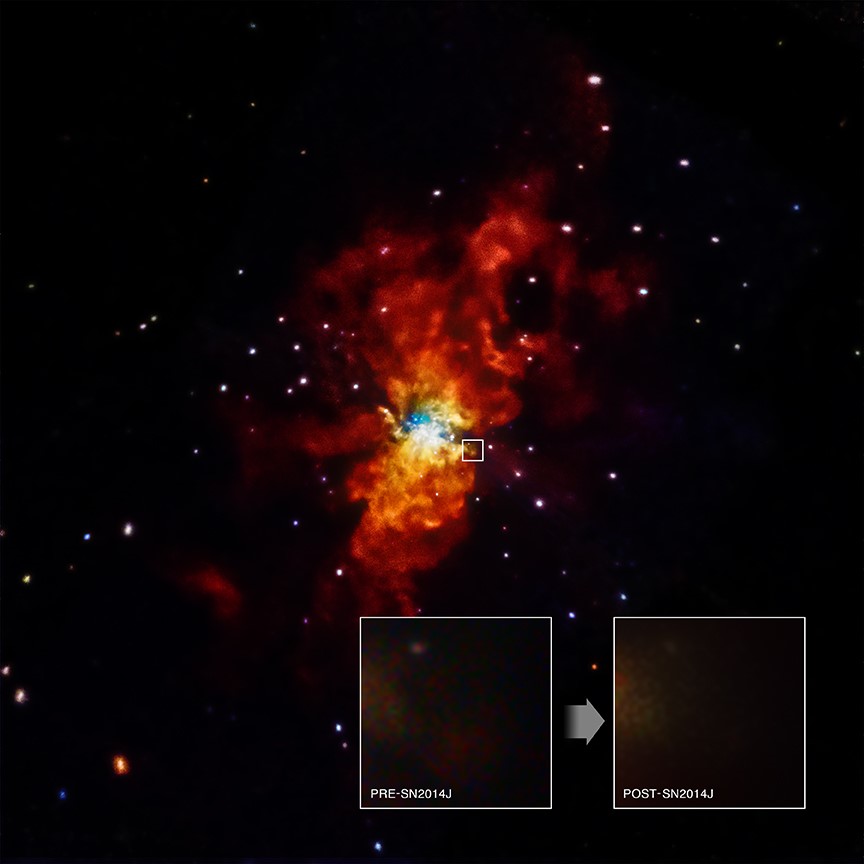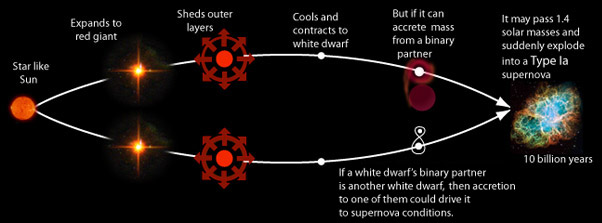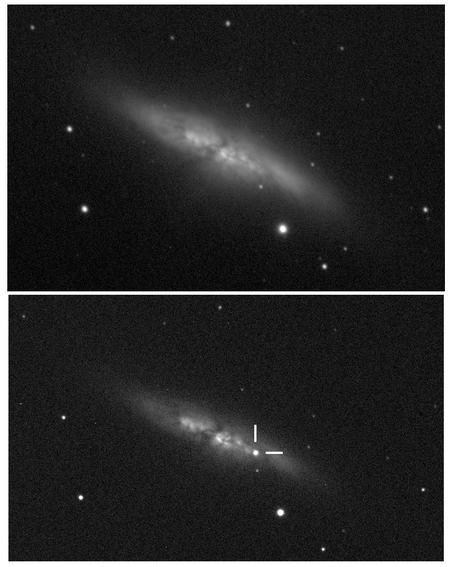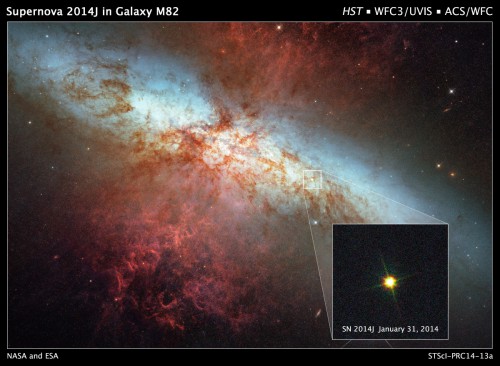
During a brief observing session in the afternoon hours of 21 January 2014, Dr. Steve Fossey and a team of undergraduate students at the University of London Observatory discovered quite by chance a very bright supernova explosion in the nearby starburst galaxy M82. In the weeks following its appearance, the supernova, named SN 2014J, became the subject of an intense multi-wavelength study, allowing astronomers worldwide to trace its evolution using an assortment of ground- and space-based telescopes. Yet, contrary to theoretical predictions regarding the causes behind this particular type of stellar explosions, a series of observations made with NASA’s Chandra and Swift space telescopes surprisingly revealed that SN 2014J exhibited no emission at X-ray wavelengths at all, leading astronomers to put further constrains on the possible formation scenarios of these types of cataclysmic cosmic events.
Supernova explosions are among the most energetic events in the Universe, marking the violent death of supermassive stars. With an energy output similar to that of the Sun during its entire lifetime, they can briefly outshine their host galaxy before fading away, over the course of several weeks or even months. Depending upon the process by which they occur, supernovae are classified as either Type Ia or Type II. The latter are the most well-known, resulting from the core collapse of stars at least eight times more massive than the Sun, when they run out of their hydrogen fuel at the end of their lives. Type Ia, on the other hand, are thought to occur either from the cataclysmic detonation of white dwarfs in binary star systems due to a constant accretion of material from their stellar companions, or from the merger of two white dwarfs that are gravitationally bound together.

Not to be confused with the less energetic nova explosions, which also involve the accretion of matter from white dwarfs in binary systems, in the case of type Ia supernovae, the infalling matter increases the mass of the white dwarf past the Chandrasekhar limit of 1.4 solar masses. Once it has passed this threshold, the latter undergoes a runaway re-ignition of carbon nuclear fusion reactions in its core, which lead to its explosive destruction. Because Type Ia supernovae explosions have well-determined and predictable light curves and a uniform absolute magnitude, they are used as standard cosmic candles by astronomers for accurately measuring distances in the Cosmos, and they have been instrumental in the ground-braking discovery of “dark energy” and the accelerating expansion of the Universe in the late 1990s.
Just such a supernova explosion (the closest of its kind since SN1972e which occurred more than 40 years ago) was discovered in January in the nearby galaxy Messier 82 by Fossey and his team of undergraduate students, using one of the automated 0.35–metre telescopes at the University of London Observatory. Messier 82, also known as the Cigar Galaxy, or M82, is an edge-on spiral starburst galaxy located at a distance of 11.5 million light-years away in the constellation Ursa Major, which undergoes a rate of intense star formation nearly 10 times higher than the Milky Way. Because of its relative proximity, astronomers around the world had the chance to observe the new supernova, designated SN 2014J, in great detail with various ground- and space-based telescopes in the weeks following its discovery, allowing them to trace the evolution of its brightness with time.

A series of pre-discovery images of M82, taken in early January with the 0.76-m Katzman Automatic Imaging Telescope, or KAIT, at the Lick Observatory in San Jose, Calif., and the 0.5-m Antarctic Survey Telescope during the course of test observations in Mohe, China, revealed that the supernova SN 2014J had gone off a week prior to its discovery. Having already reached an apparent magnitude 11.7 on the night of its discovery, and, with its luminosity peaking at magnitude 10.5 during the first week of February, SN 2014J became a popular target for amateur and professional astronomers alike. Spectroscopic measurements at optical wavelengths, taken with the ARC 3.5-m telescope at the Apache Point Observatory in New Mexico on January 22, established SN 2014J as being a Type Ia supernova, with a maximum expanding velocity of approximately 20,000 km/s, while follow-up studies with the Hubble Space Telescope 10 days later allowed astronomers to study the evolution of SN 2014J at ultraviolet, optical, and near-infrared wavelengths as it reached its peak brightness. Yet a series of observations with the Combined Array for Research in Millimeter-wave Astronomy, or CARMA, and the Very Large Array radio observatories in California and New Mexico respectively, failed to detect the supernova at millimeter and radio wavelengths, indicating that its surroundings were probably almost devoid of any material.
A new study appearing in the July 20 print issue of The Astrophysical Journal comes to reinforce this conclusion, by reporting a non-detection of SN 2014J at the high-energy part of the electromagnetic spectrum as well. As detailed in the study, a series of space-based observations of SN 2014J, conducted by a team of astronomers utilising NASA’s Swift X-ray Telescope and the Chandra X-ray Observatory, similarly failed to detect any X-ray sources at the vicinity of the supernova, in contrast to theoretical models which had predicted that the accretion of material around the progenitor white dwarf would create an expanding shock wave of supernova debris that would glow brightly at X-ray wavelengths. The absence of any such observations could only mean that whatever caused SN 2014J to go off wasn’t the result of such a matter accretion. “While it may sound a bit odd, we actually learned a great deal about this supernova by detecting absolutely nothing,” says Dr. Raffaella Margutti a Post-Doctoral Fellow at the Harvard-Smithsonian Center for Astrophysics in Cambridge, Mass., and lead author of the new study. “Now we can essentially rule out that the explosion was caused by a white dwarf continuously pulling material from a companion star.”
Furthermore, the light curve of SN 2014J shared some similar characteristics with that of another Type Ia supernova explosion, dubbed SN 2013dy, which had been discovered in July 2013 in the galaxy NGC 7250 at a distance of 55 million light-years away—both had brightened faster than what was expected for Type Ia supernovae. The behavior of both SN 2014J and SN 2013dy was counter to that of a third supernova named SN2011fe, which had been discovered in August 2011 and whose light curve was typical of a Type Ia explosion that had been caused by the accretion of material around a white dwarf star in a binary system. This may indicate that this type of supernovae doesn’t always behave in an exact, predetermined way, as predicted by various theoretical models of stellar evolution. “Now, two of the three most recent and best-observed Type Ia supernovae are weird, giving us new clues to how stars explode,” says Dr. Alex Filippenko, a professor of astronomy at the University of California, Berkeley, and leader of the KAIT research team which discovered SN 2013dy. “This may be teaching us something general about Type Ia supernovae that theorists need to understand. Maybe what we think of as ‘normal’ behavior for these supernovae is actually unusual, and this weird behavior is the new normal.”

While the non-detection of SN 2014J in X-ray and radio wavelenghts has left astronomers with a puzzle to solve, the most probable cause for the supernova explosion, according to the study’s team, is the merger of two gravitationally bound white dwarfs in a binary star system. According to theoretical predictions, since both are degenerate stars their mutual collision would produce none of the X-ray emission that is expected from the presence of an accreting disk of material in the case of a main sequence stellar companion. “In double-degenerate models the merger of two white dwarfs leads to the final explosion,” write the authors in their study. “The general expectation is that of a ‘clean’ environment with interstellar medium-like density. No stellar progenitor is expected to be detectable at the distance of SN 2014J in near ultraviolet to near infrared pre-explosion images. Additionally, since the white dwarfs were unlikely to burn hydrogen just prior to explosion, no X-ray source is expected to be found in pre-explosion images either.” The researchers are quick to point out, however, that the questions regarding the origin of SN 2014J are far from settled, underscoring the need for additional observations to help astronomers better understand the causes behind type Ia supernovae explosions and the exact mechanisms that drive them. “Our deep X-ray non-detection is consistent with this scenario, but can hardly be considered a confirmation of this progenitor channel,” they conclude. “A change in the observation strategy, with multiple deep observations obtained in the first 100 days since the explosion is needed, to better constrain scenarios with sporadic mass-loss episodes just before the terminal explosion. We advocate for such observations to be obtained for the next Type Ia supernova discovered in the local Universe.”
The intriguing results from the study of SN 2014J, may be a step toward that direction. “Being able to eliminate one of the main possible explanations for what caused SN 2014J to explode is a big step,” says Dr. Atish Kamble, also a Post-Doctoral Fellow at the Harvard-Smithsonian Center for Astrophysics and co-author of the study. “The next step is to narrow things down even further.” Besides their importance to astrophysics, these cataclysmic stellar events are also key to our understanding of the evolution of the Universe itself. Since type Ia supernovae are the standard cosmic candles by which astronomers measure cosmic distances, a better understanding of their physical properties could lead to new insights about the Universe, as well as the nature of the mysterious “dark energy” which drives its accelerated expansion. “It’s crucial that we understand exactly how these stars explode because so much is riding on our observations of them for cosmology,” adds Dr. Jerod Parrent, also from the Harvard-Smithsonian Center for Astrophysics. “SN 2014J might be a chance of a lifetime to study one of these supernovas in detail as it happens.”
As is always the case in the study of the Cosmos, every new discovery proves that the Universe is much more fascinating, enticing, and mysterious than what our human imagination and understanding can conceive.
Video Credit: NASA/CXC/A. Hobar
Want to keep up-to-date with all things space? Be sure to “Like” AmericaSpace on Facebook and follow us on Twitter: @AmericaSpace




Great post! I especially liked the video at the end.
Thank you very much Brandon! Kind regards.